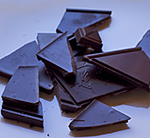At the most recent chocolate salon I attended, I was pleased to notice that a lot of attendees were really into the spirit of things and were thoughtfully tasting the different chocolatiers’ offerings and asking smart questions. A big plus of attending a salon is that you can gain a lot of insight by talking to the vendors as you sample their wares.

Since a salon is basically a mouth & stomach marathon, it’s important to pace yourself and choose carefully what to sample. You can find some wonderful new chocolate sources and refine your palate at the same time.
Of course, there were still those attendees who grabbed and ate indiscriminately. I’m not sure what they expect from the experience when they pick up a bunch of chocolates in one hand and walk away from a vendor. How will they know what they are eating or who made it if they decide later that they like something?
So for those who are new to the art of chocolate tasting, here’s some basic info and suggestions for how to train your palate for next year’s salon:
Depending on where a chocolate’s cacao was grown and how it was processed, the chocolate might have spicy, citrus, berry/fruity and/or a woody/earthy taste. To better appreciate different chocolates, it helps to do comparison tastings — like wine tastings. And like wine tastings, it can be fun to share the experience with others.
Selecting chocolates to taste
(I prefer dark chocolates, so these suggestions relate to tasting dark, not white or milk chocolates.)
If you haven’t done comparison tastings before, I’d suggest you start with plain dark chocolate bars.
Select an array of chocolate from a variety of sources. Cacao from different parts of the world really do taste different; so for a first tasting, I’d recommend finding single-source bars, meaning chocolate bars made from cacao grown and processed in one geographical area, such as Madagascar, Venezuela, or Vietnam.
Another variation to try is differing amounts of cocoa solids. Bars with higher percentages of cocoa solids tend to be more bitter, so tasting different percentages can help you discover what range you like.
Buy enough to have 1-2 ounces of each chocolate per person.
Setting up a tasting
Arrange your chocolates from sweeter to bitter (generally from least cocoa to most).
Have a palate cleanser, like warm green tea, to sip between chocolates so that you can get a clearer idea of each chocolate’s unique flavor.
Provide some light non-chocolate foods that compliment the chocolate to round out your table, such as apples or strawberries for a sweet addition, and pretzels or crackers for a salty addition.
Using your senses
When it comes to the actual tasting, use all of your senses.
Look at the chocolate. Good quality dark chocolate is shiny. If you see any powdery white areas, these are bloom. Bloom is harmless, but means the chocolate experienced some extreme temperature changes. Bloom can affect the taste of the chocolate, so proper care and handling of chocolate is important.
Smell the chocolate to see if you can detect any bitter vs. semi-sweet notes. Sometimes it helps to massage the chocolate a bit to warm it up.
Break the chocolate piece with your hands. It should snap, which means it was processed correctly and has sufficient cocoa butter content for a better “mouth feel.”
Hold the chocolate in your mouth, noting the chocolate’s texture. Some chocolates are very smooth, others can be quite grainy, especially raw chocolates. Neither is necessarily better, more a matter of personal preference. A third texture, waxy, usually indicates the manufacturer substituted a different type of fat for some/all of the cocoa butter. Thumbs down to substitutions.
Another aspect of texture to compare is how the chocolate melts in your mouth. Some chocolates are “harder”: they take longer to melt and fill your mouth with their flavor. I think that chocolates which break down faster but have enough cocoa butter to linger have a better mouth feel.
Finally, note the taste of the chocolate as you eat it. Having warmed the chocolate in your mouth first helps you note more of its overtones and undertones when you actually start chewing. The taste often changes as you eat it, so pay attention and you will probably detect a beginning, middle and end taste that lingers.
Try to describe what you are tasting. (And if you get good at this, please give me some suggestions. I find I am often at a loss for descriptive adjectives to communicate what I’ve tried.)
Rinse and repeat: Cleanse your palate and try another piece. Once you’ve got a handle on how different plain dark chocolates taste, do the same focused tasting of flavored chocolates. You’ll be able to pick up more of the subtleties and appreciate better how the chocolate and the other flavors compliment and contrast with each other.
Happy tasting!



